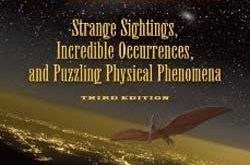SYNOPSIS:
A fascinating look at Gray Barker — a writer dedicated to the mythology of UFOs — this revealing documentary chronicles his part in giving rise to numerous UFO legends and his delight in the public stir his stories caused. Starting in the 1950s, Barker played a key role in creating and encouraging Americans’ obsession with sightings of mysterious spaceships and “close encounters” with alien beings — with little concern for the truth
REVIEW:
Directed by: Bob Wilkinson
Written by: Bob Wilkinson and Robert Tinnell
Starring: Jerome Clark, Stanton Friedman, David J. Halperin, James W. Moseley, and John Sherwood
During the 1950’s, a new study of human life outside of the planet Earth paved way for a new interest in unidentified flying objects(aka UFOs.) Many publications via books and magazines were released along with the turbulence of a rising a popularity of the concept of life outside of what we know, and a growing problem that US government faced with trying to keep potential secrets from being revealed. Bob Wilkinson’s “Shades of Gray” follows the life of Gray Barker, a influential name in the study of the UFO craze starting in the 1950’s, and led to Barker being widely published phenomena in printed media.
“Shades of Gray” begins the story of Barker with the first legend that sparked his interest, the “Flatwoods Monster.” Legend has it that in 1952, an unidentified creature was spotted in the backwoods of West Virginia, which had gleaming red aura that was nothing of this Earth. This instance was the specific event that sparked a young Gray Barker into the world of studying what could be outside our own comfort world.
The next concept Barker explored was a group of three men dressed in black uniforms, or the “Men in Black.” The “Men in Black” were sent out by the government to seek out people who “knew too much” and they would be silenced in any way possible. A hot topic within Barker’s group, the International Flying Saucer Bureau, the fear of the “Men in Black” paved way for many stories of members committing suicide, like the MK Jessup death.
“Shades of Gray” also talks about friends of Barker, and ways that Barker influenced people in his writing and investigation into the possibility of a life form outside of the planet Earth. Many of Barker’s friends claimed to have ridden on spacecrafts from outside this planet, and even communicated with the creatures from outside this world. Barker was the most prolific UFO author of the 1950’s, and produced the “Saucerian Magazine” with 3,000+ fan subscribers. Many fans enjoyed Barker’s work, with detail-oriented events and the stories were new to the Sci-fi genre of writing.
The documentary takes a dark turn when the experts begin to describe Barker’s personal life, which lead to his death on December 6, 1984. A smaller part of Barker’s life was his sexual orientation, which was deemed unsafe in the 1950’s being a homosexual. Barker was said to have the chance to leave the backwoods of West Virginia, but decided against it due to psychological problems. Barker’s death was claimed a result of alcoholism, but there is questioning that it may have been a result of aids.
“Shades of Gray” has plenty of historical content to be covered, and friends and family of Barker that add to the documentary’s realism. Some of the cast include folklore experts, friends of Barker, writers of ufology magazines, family members, and much more. Barker’s legacy is adherent today in movies and television series, and is most apparent in a movie entitled by the same name that Barker created, “Men in Black.”
Anyone who is interested in the birth of the ufology study should give Bob Wilkinson’s “Shades of Gray” an attentive viewing. Without Barkers brave investigation into the concept of flying saucers and out of this world creature, the sci-fi genre would have never been given the kick start as had been done in the 1950’s. Barker’s publications also sparked interest in the sci-fi genre writing, which lead to movies and many magazines being made to satisfy fans of the paranormal’s urges.
 Horror News | HNN Official Site | Horror Movies,Trailers, Reviews
Horror News | HNN Official Site | Horror Movies,Trailers, Reviews








It seems an odd coincidence that the fictional movie and/or TV series “Fifty Shades of Grey” received huge worldwide publicity during the same year that this documentary movie about Gray Barker (Shades of Gray) was released. I can’t help suspecting that someone wanted the movie about Barker buried. If you do a search for “Shades of Gray” it is virtually impossible not to be swamped with 18 million irrelevant links, mostly relating to “Fifty Shades of Grey.” I believe this cannot be unintentional.